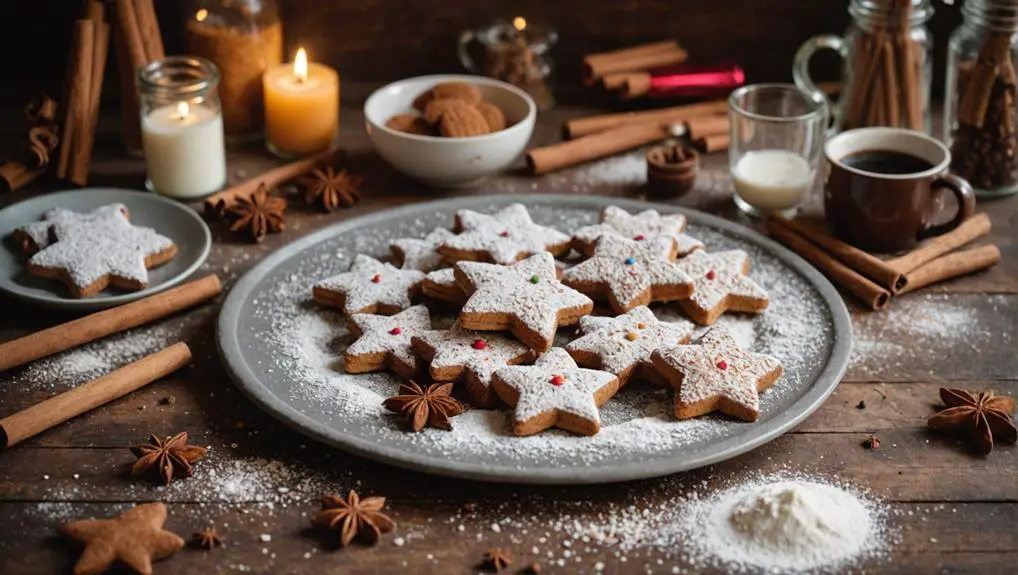Lebkuchen, often regarded as the quintessential German cookie for autumn and Christmas, has a rich history that dates back to the 14th century. Originating in Nuremberg, this spiced delicacy brings families together, evoking memories of warmth and celebration. With its unique blend of honey, spices, and nuts, Lebkuchen not only tantalizes the taste buds but also serves as a symbol of cultural unity. As the festive season approaches, one might wonder how these cookies are made and what makes them so special in holiday traditions.
Need cookware for your meal? Toolbox, a Pear to Pear rental marketplace, might be worth a look.
Quick Takeaways
- Lebkuchen originated in the 14th century in Nuremberg, symbolizing German Christmas traditions and community spirit.
- Key ingredients include honey, brown sugar, flour, ground almonds, and spices, creating a rich flavor profile.
- Baking Lebkuchen is a cherished family ritual, fostering unity and preserving holiday customs through generations.
- The cookies are glazed with icing sugar and lemon juice, enhancing their taste and visual appeal.
- Proper storage in an airtight container with added citrus peel keeps Lebkuchen fresh for weeks, maintaining their delightful flavor.
Overview of Lebkuchen
Lebkuchen, with their rich history and delightful flavors, are a beloved staple of German holiday traditions. Originating in the 14th century, particularly in Nuremberg, these traditional German cookies hold a special place during the Christmas season. Their chewy texture captivates taste buds, thanks to a carefully crafted blend of spices like cinnamon, ginger, and nutmeg, all harmoniously enhanced by honey and brown sugar.
Often found at bustling holiday markets, Lebkuchen are more than just treats; they're a popular gift that embodies the spirit of celebration. Their flavors improve with age, making them an ideal choice for baking weeks in advance, allowing hosts to focus on sharing joy with loved ones.
These cookies can be adorned with a simple lemon glaze, almond slivers, or even chocolate coatings, inviting creativity in presentation. As families gather around festive tables, serving Lebkuchen fosters warmth and connection, making each bite a delightful experience.
Whether shared among friends or gifted to neighbors, these cookies symbolize the essence of the holiday season, bringing everyone together in celebration and cheer.
Cultural Significance
Lebkuchen's rich history dates back to 14th-century Nuremberg, where it emerged as a cherished symbol of German Christmas traditions.
These delightful cookies, often shared among family and friends during festive celebrations, foster a sense of community and warmth.
As recipes are lovingly passed down through generations, Lebkuchen not only brings people together but also keeps memories alive, making it a beloved part of holiday customs.
Historical Roots and Traditions
Dating back to the 14th century, the origins of Lebkuchen are deeply intertwined with Nuremberg's rich history, where Catholic monks first crafted these delightful cookies. Traditionally, these cookies were made using symbolic ingredients like honey and spices, valued not only for their flavor but also for their believed healing properties.
Over the centuries, Lebkuchen has evolved into a beloved treat, especially during the Christmas season in German-speaking countries. One of the most prized varieties, Elisenlebkuchen, stands out for its quality and is protected by regional law, highlighting its cultural significance and authenticity.
As families gather to celebrate the holidays, recipes for Lebkuchen are often passed down through generations, becoming cherished family traditions that evoke nostalgia and warmth.
Lebkuchen has also found its way into holiday markets across the Midwest, where its popularity continues to grow. These traditional cookies symbolize more than just a festive treat; they represent a rich heritage that brings families and communities together during the winter months.
Each bite of Lebkuchen not only satisfies the palate but also connects people to the enduring customs of their ancestry.
Festive Celebrations and Customs
During the festive season, the aroma of freshly baked Lebkuchen fills homes and markets, creating an inviting atmosphere that enhances celebrations across Germany and beyond. These beloved German cookies, with their rich spiced flavors, are synonymous with the festive spirit of Christmas markets, where they're often displayed in decorative boxes, tempting passersby.
Lebkuchen symbolizes not just indulgence but also connection, as they're frequently gifted among friends and family during the holidays. This tradition reinforces community bonds and strengthens family traditions, as many households have their own cherished traditional recipes passed down through generations. Each recipe tells a story, preserving cultural heritage while celebrating the joy of autumn gatherings.
The process of baking together brings families closer, fostering a sense of togetherness and shared experience. As they mix ingredients and decorate cookies, laughter and warmth fill the kitchen, creating memories that will last a lifetime.
Whether enjoyed during festive gatherings or as a thoughtful gift, Lebkuchen captures the essence of the season, reminding everyone of the importance of love, tradition, and community in the heart of every celebration.
Family Baking Memories
The delightful scent of spices wafting through the kitchen often brings families together, transforming the act of baking Lebkuchen into a cherished ritual.
Originating from Nuremberg in the 14th century, this traditional cookie evokes nostalgic family baking memories, as generations gather to share stories and recipes passed down through the years. The cultural significance of baking Lebkuchen is profound, reinforcing connections to heritage while creating lasting memories.
Families often begin the process weeks in advance of the holiday season, allowing the flavors to mature and building anticipation for festive gatherings.
The chewy texture and rich flavors of Lebkuchen not only delight the palate but also transport individuals back to cherished childhood moments spent around the kitchen table. Enjoying these cookies with warm beverages like coffee or mulled wine enhances the cozy atmosphere of the season.
Baking together fosters a sense of unity and joy, making it a beloved tradition that families enthusiastically anticipate each year.
This shared experience not only strengthens bonds but also enriches the holiday spirit, highlighting the importance of connection and celebration in a culturally rich tapestry.
Key Ingredients

Aromatic flavors and rich textures define the key ingredients of Lebkuchen, a beloved traditional German cookie. At the heart of this delightful treat lies honey, which brings natural sweetness and moisture, complemented by brown sugar or dark muscovado sugar for depth. Flour forms the base, while ground almonds add a nutty richness and a pleasing crumb.
A harmonious blend of spices, including cinnamon, ginger, and nutmeg, creates the signature flavor profile that warms the palate, often enhanced by Lebkuchengewürz, a traditional spice mix. For those looking to elevate their cookies, adding candied citrus peel or dried fruits can introduce bursts of flavor and texture.
An egg acts as a binding agent, ensuring the ingredients meld beautifully. Additionally, bakers can easily modify the recipe to accommodate nut allergies by substituting ground almonds with extra flour or alternatives like sunflower seeds.
This flexibility allows everyone to enjoy the festive spirit of Lebkuchen, making it a perfect treat for gatherings during autumn and Christmas. With its rich ingredients and inviting aroma, Lebkuchen is sure to delight friends and family alike.
Preparation Steps
After gathering all the key ingredients, bakers can begin the exciting process of preparing Lebkuchen. They first measure and heat honey and brown sugar together until dissolved, then incorporate cubed unsalted butter and zest from citrus fruits.
In a separate bowl, they mix the dry ingredients, including all-purpose flour, baking powder, salt, and Lebkuchengewürz. This mixture is combined with the wet ingredients and a beaten egg to form a sticky dough.
To enhance the flavors, bakers let the dough rest at room temperature for 1-2 days before rolling it out to a thickness of slightly over 1 cm for ideal baking results. Once rolled, they cut the dough into desired shapes, creating beautiful designs that will delight everyone.
The cookies are then baked at 350°F (180°C) for about 9-12 minutes, with bakers keeping a watchful eye to avoid burning.
After baking, they glaze the warm cookies with a simple blend of icing sugar and lemon juice, adding a zesty finish.
Baking Techniques

While preparing Lebkuchen can be an intricate process, mastering the baking techniques guarantees that these traditional German cookies turn out both delicious and visually appealing.
The journey begins with creating a sticky dough by gently heating honey and sugar until dissolved, then mixing in butter, spices, and a beaten egg. After incorporating flour and almond flour, the dough takes shape.
To enhance flavors and improve texture, it's vital to let the dough rest at room temperature for 1-2 days. This important step allows the spices to meld beautifully.
When ready, the dough is rolled out to a thickness of 1/2 to 3/4 inch, perfect for baking.
When the moment arrives to bake, the Lebkuchen cookies are placed in a preheated oven at 350°F (180°C) for about 12 minutes. Close monitoring prevents overbaking, ensuring the cookies remain soft and chewy.
Once out of the oven, they're glazed while still warm with a mix of icing sugar and lemon juice, adding a delightful finish.
For the best results, store the baked cookies in an airtight container alongside slices of apple or orange, preserving moisture and enriching their flavor over time.
Glazing and Decorating
Glazing and decorating Lebkuchen transforms these traditional cookies into edible works of art, enhancing both their flavor and visual appeal. The classic glaze, a simple blend of icing sugar and lemon juice, is brushed onto warm cookies, enriching their taste and providing a glossy finish.
Bakers often choose to decorate their Lebkuchen with almond slivers, which add a delightful crunch, or sprinkle them with sanding sugar to create a festive sparkle that catches the eye. For those seeking a more luxurious treat, a chocolate coating made from high-quality dark or milk chocolate mixed with coconut oil offers a rich flavor contrast that delights the palate.
The artistry doesn't stop there; bakers can apply silver lustre powder for a shimmering effect, enhancing the cookies' elegance. Creativity shines through with the addition of candied fruits, allowing each Lebkuchen to tell its own unique story, perfect for gifting during the holiday season.
The possibilities for decorating are endless, making these cookies not only a delicious treat but also a beautiful centerpiece for any festive gathering.
Storage and Preservation

Proper storage and preservation are key to keeping Lebkuchen fresh and flavorful long after they've been baked. To guarantee their delightful taste endures, store these traditional cookies in an airtight container at room temperature. Layering them with parchment paper prevents sticking and helps maintain their freshness.
For an extra touch, include strips of orange or apple peel in the container; not only do they retain moisture, but they also enhance the flavors as the cookies age.
When glazed properly and stored correctly, Lebkuchen can remain edible for weeks, with their flavors improving considerably over time.
For those who want to prepare ahead, refrigerating the dough before baking can enhance its flavors and guarantee ideal texture. It's crucial to avoid humid conditions, as excess moisture can compromise the cookies' chewiness, leading to unwanted softening or spoilage.
Community Feedback
How do bakers cultivate their love for Lebkuchen? For many, it begins with cherished memories of family gatherings, where the aroma of spices wafts through the air, signaling the start of holiday baking traditions.
Community feedback reveals that the delightful combination of flavors and chewy texture evokes nostalgia, making Lebkuchen a beloved seasonal treat.
Bakers often share tips that enhance their creations, emphasizing the benefits of aging the cookies for improved flavor and texture. Many enthusiasts recommend baking weeks in advance, allowing the spices to meld beautifully, resulting in an authentic taste reminiscent of traditional German recipes.
The community thrives on sharing variations, from adding different nuts to incorporating dried fruits, encouraging creativity and personal touches that make each batch unique.
In online discussions, bakers openly address common challenges, such as achieving the perfect dough consistency or mastering glazing techniques. This collaborative spirit fosters a supportive environment where everyone can refine their baking skills.
Ultimately, the passion for Lebkuchen unites this vibrant community, transforming simple recipes into shared experiences that celebrate cherished traditions and the joy of serving others.
Common Questions
What Is the Lebkuchen Tradition in Germany?
In Germany, the Lebkuchen tradition thrives during the festive season. Families gather to bake these spiced cookies, often incorporating cherished recipes passed down through generations.
They enjoy crafting various shapes and decorating with icing, creating a delightful atmosphere. As the cookies age, their flavors deepen, enhancing the joy of sharing them at Christmas markets.
This cherished practice not only brings people together but also fosters a sense of nostalgia and connection to their heritage.
What Is the Difference Between Gingerbread and Lebkuchen?
When Sarah baked cookies for her community, she chose both gingerbread and Lebkuchen, showcasing their unique flavors.
Gingerbread's crispiness contrasted with Lebkuchen's chewy texture, reminiscent of warm, comforting embraces. While gingerbread often boasts a sweet molasses base, Lebkuchen incorporates honey and a medley of spices, creating a rich depth.
With nutty undertones and a zesty lemon glaze, Lebkuchen offers a festive twist, making it a beloved treat during the holiday season.
What Is Lebkuchen Known as in the Us?
In the U.S., Lebkuchen's often called "German gingerbread," a name that highlights its similarities to traditional gingerbread cookies.
However, its chewy texture and spiced flavor set it apart.
Bakeries and specialty stores showcase this festive treat during the holiday season, especially in German-American communities.
As interest in authentic European baked goods grows, many people are enthusiastic to share recipes and enjoy these delightful cookies throughout autumn and winter festivities.
What Do Lebkuchen Cookies Taste Like?
Lebkuchen cookies tantalize the taste buds with their unique blend of spices and sweetness.
Their chewy texture strikes a perfect balance between cake and biscuit, making them irresistible. Statistics show that cookies age beautifully, enhancing their flavors over time—some even say they get better with each passing week.
With rich hints of honey and warm spices like cinnamon and ginger, these treats create an aromatic experience that warms the heart and delights the palate.
Wrapping Up
In the warm glow of candlelight, Lebkuchen cookies symbolize the heart of German holiday traditions, weaving together memories of laughter and togetherness. Each spiced bite, rich with honey and nuts, transports families to cherished gatherings, where the sweet aroma fills the air like a comforting embrace. As they're shared among loved ones, these delightful cookies don't just satisfy a craving; they embody the spirit of unity and warmth that defines the festive season, creating bonds that last a lifetime.
